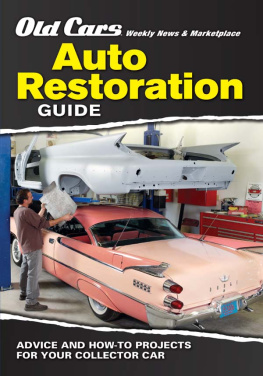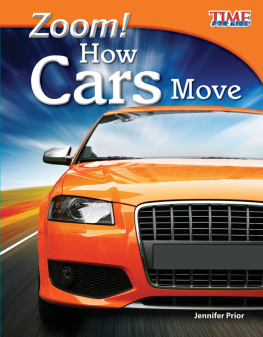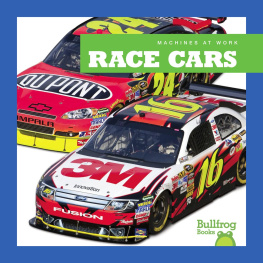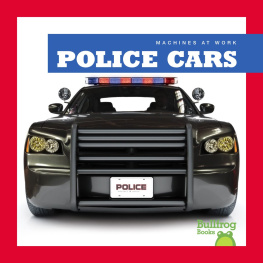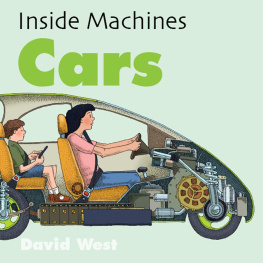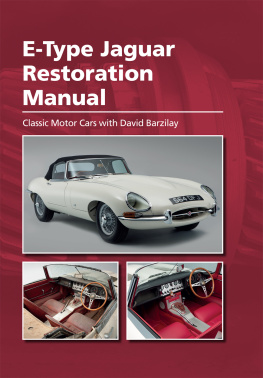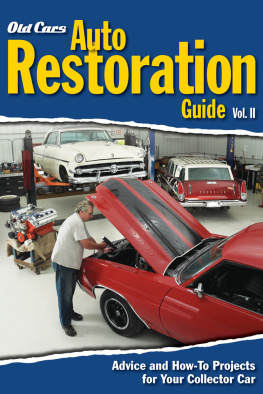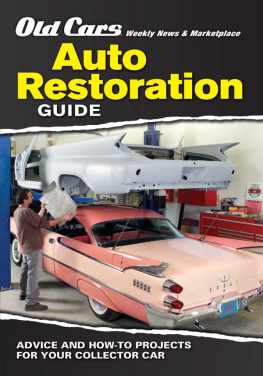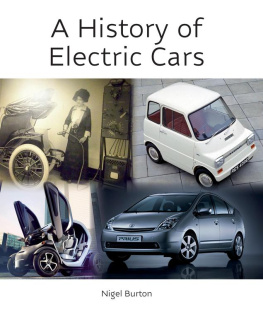Contents
Guide
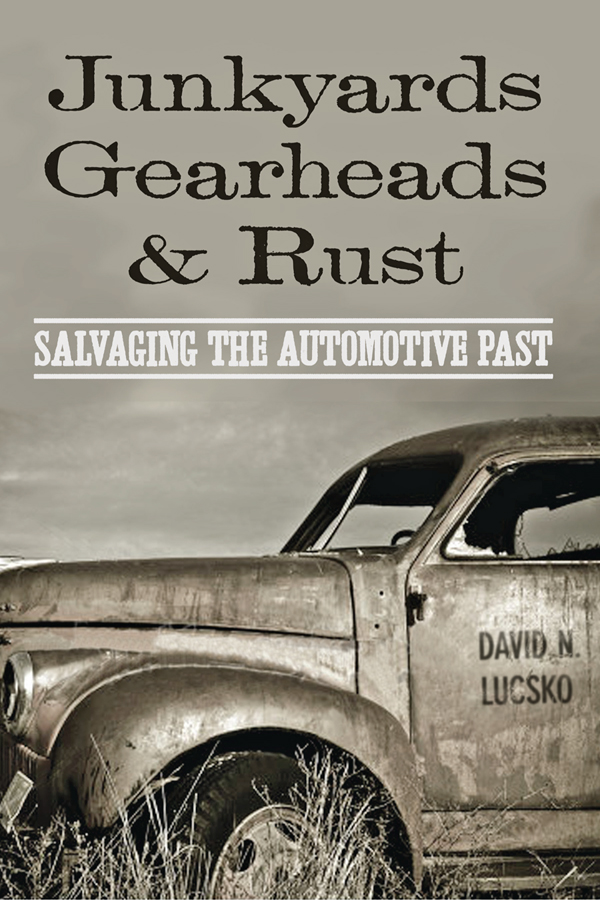
Junkyards, Gearheads, and Rust
Junkyards, Gearheads, and Rust
Salvaging the Automotive Past
David N. Lucsko
JOHNS HOPKINS UNIVERSITY PRESS BALTIMORE
2016 Johns Hopkins University Press
All rights reserved. Published 2016
Printed in the United States of America on acid-free paper
9 8 7 6 5 4 3 2 1
Johns Hopkins University Press
2715 North Charles Street
Baltimore, Maryland 21218-4363
www.press.jhu.edu
Library of Congress Cataloging-in-Publication Data
Lucsko, David N., 1976
Junkyards, gearheads, and rust : salvaging the automotive past / David N. Lucsko.
pages cm
Includes bibliographical references and index.
ISBN 978-1-4214-1942-8 (hardcover : alk. paper)ISBN 1-4214-1942-4 (hardcover : alk. paper)ISBN 978-1-4214-1943-5 (electronic)ISBN 1-4214-1943-2 (electronic) 1. Automobile graveyardsUnited States. 2. AutomobilesPartsUnited States. 3. Automobile wrecking and used parts industryUnited StatesHistory. I. Title.
TD795.4.L83 2016
338.4'762920973dc23 2015026986
A catalog record for this book is available from the British Library.
Special discounts are available for bulk purchases of this book. For more information, please contact Special Sales at 410 -- 6936 or specialsales@press.jhu.edu.
Johns Hopkins University Press uses environmentally friendly book materials, including recycled text paper that is composed of at least 30 percent post-consumer waste, whenever possible.
For Walter, and for Bob
Contents
Preface
When I was four, I wanted one toy more than any other: Clydes Car Crusher, a set that let you form small cars out of tinfoil using molds and then smash them into little cubes with a miniature junkyard crusher. I never got a Clydes set of my own, but when I was five, I got something even better, at least to my mind. That year my family moved from one borough in the Pittsburgh area to another, and from my bedroom window on the front of our new house I could clearly see, over the crest of a hill on the horizon, the cranes and piles of cars at a salvage yard a couple of miles away. Eighteen months later we moved again, this time to a more idyllic town, south of Atlanta. To my disappointment, all that could be seen on the horizon from my new window was an endless line of southern pines. But to my delight, anytime we drove to the mall in the next county, or to downtown Atlanta itself, I had plenty of opportunities to see derelict cars rusting away in fields or lined up in roadside salvage yards.
Im not quite sure why I found these sights so fascinating when I was a kid. What I do know is that when I was a teenager, the salvage yards scattered across the southern metro area became vitally important to me as sources of odds and ends for my daily driver. Over the years I bought emblems, fenders, shift knobs, dashboard switches, and several speedometers from the local yards. Sometimes I also visited them just to browse around, poking and prodding at the wrecks as if they were department-store goods and I a window shopper. On more than one occasion, I missed my chance to rescue a vintage car, too; Ill never forget the clean, rust-free, white-on-white 1967 Westfalia camper that was inexplicably moldering away in a yard on Highway 85 or the guilt I felt when I realized that I was in no position to save it from its fate. Yes, once upon a time, I was a junkyard junkie.
In the years since, my trips to salvage yards have grown fewer and farther between. This is because the parts I tend to need for my older cars simply dont exist at most of them anymore; the wrecks that would have had them once upon a time have now aged out of the system, having grown too old to be kept around profitably. But salvage yards have never been far from my mind. While working on my dissertation and my first book, I encountered numerous references in Hot Rod , Popular Hot Rodding , and other periodicals to the use of parts from salvage yards in everything from street rods to all-out restoration projects. As a result, the thought occurred to me that an examination of salvage yards and the practices of reuse and repurposing common among gearheads might be a good way to follow up on my research on the culture and technology of the high-performance hobby. So I started collecting articles and references on the side. Shortly after my first book went to press, I used what I had gathered to draft a conference paper about clunker programs and zoning rules. Six years then flashed by in a blur, and now I find myself sitting in my office on a lovely spring afternoon, drafting the acknowledgments to Junkyards, Gearheads, and Rust .
Were it not for the generous assistance of a number of individuals and institutions, I never would have been able to see this project through. First and foremost, I thank my colleagues in the History Department at Auburn University, especially Bill Trimble, who graciously read and commented on several drafts of ; the students who took my graduate seminar on waste and recycling in the spring of 2012; and last but certainly not least, all of the faculty members and graduate students who gather at Halftime each week. For their valuable feedback and suggestions, I also thank those who attended the History, Technology, and Society colloquium at Georgia Tech in November of 2011; the Research Seminar at the Hagley Museum and Library in February of 2013; the meetings in Pittsburgh (2009), Cleveland (2011), and Portland (2013) of the Society for the History of Technology (SHOT); and the Twenty-Fifth Anniversary Symposium of the Doctoral Program in Science, Technology, and Society at MIT in November of 2013. Any errors of fact or interpretation are mine alone, of course.
An abbreviated version of peared in American Motor Sport: The Checkered Literature on the Checkered Flag, a historiographic essay in A Companion to American Sport History , ed. Steven Riess (Wiley Blackwell, 2014), 31333. I thank the editors at Wiley Blackwell for their permission to reproduce those portions here.
I also thank the anonymous referees at Technology and Culture and Johns Hopkins University Press for their feedback and encouragement. For supporting this project from day one and for seeing it through to the end, I thank Bob Brugger, my editor at Johns Hopkins University Press. I also thank Kathryn Marguy and the rest of the staff at the press for everything theyve done to bring this volume into print. For their tireless assistance, I thank the librarians at Auburn University; at the University of California, Irvine; at the University of California, Riverside; and The Henry Ford.
For generously allowing me to reproduce their copyrighted images, I thank G. Bugg Jr. of the National Street Rod Association; Eric Kaminsky of Amos Press, Inc.; Michael McNessor of Hemmings ; Lyle R. Rolfe; Phil Skinner; and George Trosley. For taking the time to either locate archived and unarchived resources, sit for formal interviews, or both, I thank the Specialty Equipment Market Associations (SEMAs) Chris Kersting, Peter MacGillivray, Steve McDonald, and Stuart Gosswein; Alexa Barron of the California Air Resources Board; Rob Kinnan, David Freiburger, and Mike Finnegan of Hot Rod ; Phil Skinner; and Kem Robertson.
For financial assistance while researching this project, I thank both the College of Liberal Arts and the Department of History here at Auburn. For helping me in so many ways as I juggled this book project, my teaching load, and my work as SHOT secretary, I thank Bruce Seely, Francesca Bray, Bernie Carlson, and Jane Carlson. For countless conversations about all things automotive, and for being such good friends since I first came to Auburn, I thank Dave Burke, Jim Hoogerwerf, Alan Meyer, and Bill Trimble. I also thank Roe Smith, my graduate advisor, for his support over the last decade and a half, as well as Bob Post and Joe Schultz, who patiently listened as I struggled early on to explain why I thought junkyards were a good topic, and then encouraged me to follow through. I thank John Staudenmaier, too, for giving me a shot at Technology and Culture a decade ago, and for being such a good friend and mentor ever since. I thank my mother, Susan Lucsko, for putting up with me and all my cars through the years; Mr. Vimbainjer and Korylya deserve a pat on the back as well. I also want to give a heartfelt nod to Danny Lucsko, my father, Scrabble partner, fellow fan of old-school garage rock, and steadfast friend, who succumbed to cancer less than one month after his sixty-second birthday in 2012.


